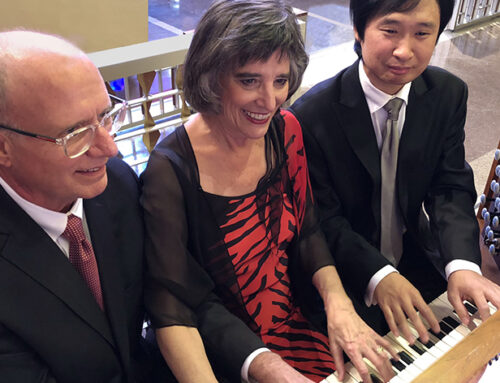The Day of Pentecost in New York City — a study in contrasts.
I started the day with worship at Abyssinian Baptist Church in Harlem. The church was founded in 1808 and the beautiful building dates from 1923. The gospel choir was great, there were some incredible soloists, and this is one place where the congregational singing was quite inspiring.
I was surprised by the formality of the worship, and by the extensive use of the pipe organ. A spark of joy was ignited when I noticed that the two names listed on the cover of the service bulletin were those of the Senior Pastor and the Minister of Music.
What I remember most about the experience, though, is the spark and beauty of Helena Duncan, the 85-year-old woman who sat next to me. What a welcome she gave me, and she was so adorable, giving me instructions on using the hymnal, finding the responsive reading, and she kept pointing out which minister did this and which minister did that. Perspective: how do I welcome the stranger?
As you can imagine, the experience of a cab ride from Harlem to Park Avenue was pretty weird — the journey between two very different worlds.
I arrived at St. Bartholomew’s Episcopal Church just in time for the 11:00 procession. It was a festival service, with the all-paid choir singing a choral mass. One thing I really liked at St. Bart’s was that the children left only for the Sermon, and they returned during the creed. There were only ten of them, but, imagine that at All Saints. We could still honor the roots of our tradition with the Nicene Creed, but with our throngs of children entering, who would notice the disturbing language?
The main purpose of my visit to St. Bart’s was to interview the Director of Music, roughly of my vintage, to discuss his growing program and staff, and how he deals with the challenges of administration. It was also really wonderful to spend some time sharing what the spark is that drives both of us, and how that is manifest in our current positions.
Pentecost afternoon: Evensong at St. Thomas’ Episcopal, Fifth Avenue, and Jazz Vespers at St. Peter’s Lutheran, in the Citicorp Plaza. Interestingly enough, my reaction to both of these very different services was quite similar. The music at both was very beautiful, but I found the overall liturgical and theological context to be quite stiff.
The final four days of this leg of the sabbatical were spent at a wonderful, thought-provoking conference — Emancipatory Liturgies for Liberative Churches — held at the Episcopal Divinity School in Cambridge, Massachusetts. A theologian from SMU, Marjorie Proctor-Smith, set the tone in her keynote address, entitled Moving Mountains: Liturgy As Transformation. She said, “Much is at stake in the words we use in liturgy. Our religious language and rituals can reinforce oppressive ideas, or deny them.”
For me, though, the highlights were two of the workshops I attended: Freedom Singing from the African-American Tradition led by Janice Allen and Building A Vocal Community led by Ysaye Barnwell (of Sweet Honey In The Rock). She is not only an incredible musician, but a spiritual giant; it was truly amazing what she offered us and what she was able to draw out of us.


